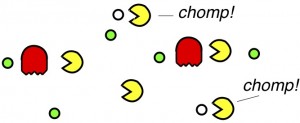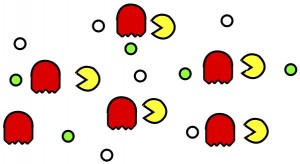Human bodies are naturally equipped with elaborate defense mechanisms to squelch intruding microorganisms. But some viruses, like HIV, are able to slip under the immune system radar and set up permanent residence in a human host. Exactly how this feat is accomplished is not known for certain, but a better understanding of virus war tactics is key to developing effective medical treatments.
Some evidence suggests that viruses like HIV are able to avoid destruction by tricking the body into overproducing a type of cell that suppresses the immune system. A new study in PNASProceedings of the National Academy of Sciences substantiates this theory and offers insight into how medicine can counter this.
The immune system is complicated, but you can sort of think of it with a Pac-Man analogy (Disclaimers: I don’t wish to make light of this subject, however I am having trouble thinking of another analogy and the immune system is confusing. Also, though I minored in biology in college, I am an organic chemist, not an immunologist. I also haven’t played much Pac-Man). Here are the participants:

Pac-Man gets the honor of being a virus-killer cell – called a CD8+ T cell. This is one of the cells produced by the body’s immune system. Here, the white circles are virus particles, and the CD8+ T cells are responsible for killing them. Now unfortunately, these virus-killers are also capable of killing normal human cells if allowed to run amuck. To prevent this, there has to be some kind of checks-and-balances system. So, there’s a second type of immune system cell, called a Treg (regulatory T cell). The Tregs are able to suppress the activity of the CD8+ T cells, to make sure they don’t just kill everything in sight. This is what a normal virus infection might look like:

However, it seems that some viruses can trick the body into producing way too many Tregs. With so many Tregs around, the CD8+ T cells can hardly do any killing at all, not even of viruses. Thus, an infection with a virus like HIV might look something like this:

During a chronic virus infection, the CD8+ T cells become “exhausted” (technical term!), presumably from the extra Tregs around. Researchers have been wondering – if you can get rid of some of those Tregs, could the exhausted CD8+ T cells recover and start killing viruses again?
The answer is yes, according to the authors of this paper. They infected mice with a type of mouse virus (FV)friend virus that, like HIV, is able to establish a chronic infection.
 They didn’t use run-of-the mill mice, though. These mice had been genetically modified so that their Tregs had an Achilles heel. The Tregs could be selectively eliminated at will by the researchers via injection with a particular toxin, a toxin that would not normally affect Tregs. This genetic modification allowed the researchers to control Treg levels – something that wouldn’t be easily achievable with regular mice.
They didn’t use run-of-the mill mice, though. These mice had been genetically modified so that their Tregs had an Achilles heel. The Tregs could be selectively eliminated at will by the researchers via injection with a particular toxin, a toxin that would not normally affect Tregs. This genetic modification allowed the researchers to control Treg levels – something that wouldn’t be easily achievable with regular mice.
After the FV infection had set in, and Treg levels were presumably high due to the virus’s influence, the researchers injected the mice with the Treg-suppressing toxin. In theory, the resulting drop in Treg activity would allow the CD8+ T cells to recover and start killing viruses again.
And this is exactly what seemed to happen. As the mouse’s Treg activity started to decrease, the concentration of virus particles in the mice started to get lower. The researchers found evidence that the CD8+ T cells were doing the virus-killing when they noticed increased levels of certain signalling molecules produced by CD8+ T cells.
The results of this study suggest that chronic infections in humans, such as HIV, could potentially be treated by supressing human Treg cells. However, the use of such a therapy would first require a lot more research. Although HIV, like FV, is believed to suppress the immune system by increasing Treg activity, it paradoxically stimulates the immune system in other ways. It is possible that medically depleting Tregs could actually exacerbate disease progression in an HIV-infected individual. Further research is certainly in order.
Citation:
Dietze, K., Zelinskyy, G., Gibbert, K., Schimmer, S., Francois, S., Myers, L., Sparwasser, T., Hasenkrug, K., & Dittmer, U. (2011). Transient depletion of regulatory T cells in transgenic mice reactivates virus-specific CD8+ T cells and reduces chronic retroviral set points Proceedings of the National Academy of Sciences DOI: 10.1073/pnas.1015148108


Interesting post! I like the analogy of Pac Mans for the CD8 cells, although I haven’t seen it yet in my Immunology class… perhaps I’ll mention it. 🙂
Thanks! I think you will know better than me at what point the analogy falls apart.
How do the viruses do this, cause the body to produce too many treg cells. please explain this at a chemical level. also there are a few questions i have about the virus which i would like to settle by performing actual experiments, but I am only in my senior year (12th grade) do you think you could help?